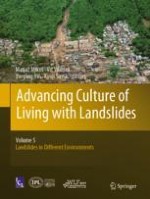2017 | OriginalPaper | Chapter
Small Flume Experiment on the Influence of Inflow Angle and Stream Gradient on Landslide-Triggered Debris Flow Sediment Movement

Authors : Hefryan Sukma Kharismalatri, Yoshiharu Ishikawa, Takashi Gomi, Katsushige Shiraki, Taeko Wakahara
Published in: Advancing Culture of Living with Landslides
Publisher: Springer International Publishing
Activate our intelligent search to find suitable subject content or patents.
Select sections of text to find matching patents with Artificial Intelligence. powered by
Select sections of text to find additional relevant content using AI-assisted search. powered by
